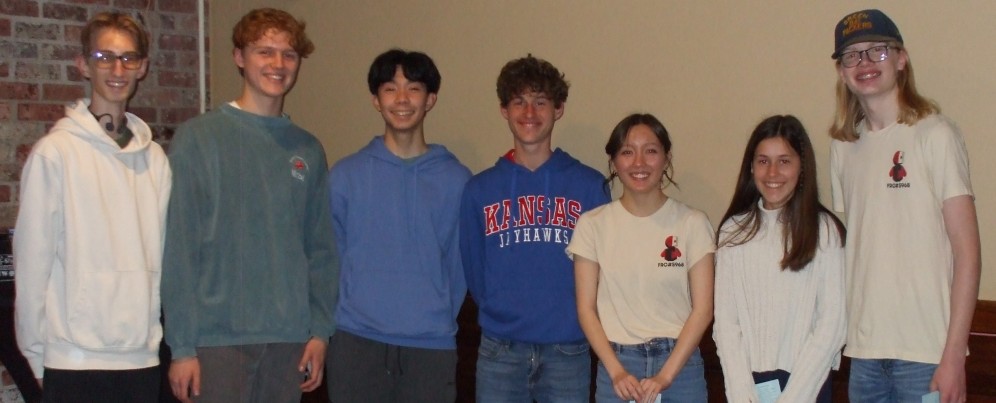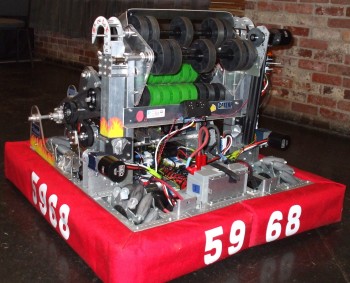The "Manhattan Optimist Club Bulletin": Vol. 2024 #26: 3-27-24
VOLUME 2024 March 27, 2024 NUMBER 26
President Bill Wisdom welcomed the membership and guests and noted the passing of Bruce Spellman, then presented reflection on celebration and celebrating a successful Spaghetti Dinner with special thanks to Jim Franke. The flag salute followed.
 Mike Fincham introduced the MHS Robotics team members, Layne Burgett, Captain, a senior; Allina Dougherty, Vice-Captain, a senior; Patrick Fu, Administration Head, a junior; Dawson Raw, Build Team Head, a sophomore, Mason Gish, a sophomore, Segun Gish, a freshman, Jack Dunning, a sophomore, and Jennifer Karr, faculty supervisor for the Robotics Club.
Mike Fincham introduced the MHS Robotics team members, Layne Burgett, Captain, a senior; Allina Dougherty, Vice-Captain, a senior; Patrick Fu, Administration Head, a junior; Dawson Raw, Build Team Head, a sophomore, Mason Gish, a sophomore, Segun Gish, a freshman, Jack Dunning, a sophomore, and Jennifer Karr, faculty supervisor for the Robotics Club.
Layne Burgett, Captain and President of the Robotics Club began the team’s presentation and thanked the Optimist for having them present today. Other team members introduced themselves and joined in at various times.
There are a total of 35 students involved in the Robotics Club at MHS. They participate in the First Robotics Program which is an international program; MHS’s team is named the Little Apple Cyborgs. Their mentors are Amy Hageman, Physics teacher MHS, Randy Pushee, Shop teacher MHS, Sundara Ghatty, physics teacher MHS, Cody Rebholz, and Jennifer Karr, faculty supervisor.
The team started in 2015 and the robots were constructed of wood. They were winning rookie awards because of the simple wood construction and rudimentary materials. As they progressed, they began to build robots out of aluminum and include more sophisticated electronics.
Every year there is a First Robotics competition which usually takes place in larger cities, such as Kansas City. They take one robot to the main competition. When you build a robot, you have to focus on funding the construction and allocating the people to build it. In addition, you must program the computer to accomplish the assigned task. Fundraising is a major part of the process. They contact businesses to sponsor them. Some teams have sponsors who provide far greater support than we have, thus they have more up to date equipment to both construct the robot and equip the robot with motors, electronics etc. There are limitations on the amount you can spend on the robot, however, there are no limitations on the amount of equipment you can have to build the robot; many teams have far larger shops and more sophisticated equipment to do the build.
The Build Team is the largest team on the project. Each year they get their playing field and their assignment of what they need their robot to do. This year, they had to design a robot to pick up rings in the field, then deposit them in an elevated basket. The entire team meets around the first of January to do an extensive brainstorming session to design a robot to accomplish the assigned task within the available funding. They then design the robot, build it and test and retest until it functions properly and is ready for competition. This year’s robot is named the Pizza Oven because of its appearance.The programming has gotten more sophisticated over the years. The robot has to move autonomously for the first 15 seconds, then one of the students can use a controller to steer the robot around the course. There are qualification matches made up of three random teams that do ten matches and depending on the robot’s performance, it may get to the finals. These robots are not “Battle Bots” like you see on TV. They are in competition, but only to perform the task, not to destroy each other. However, occasionally there are accidents. Teams do help each other out at competitions, sometimes with parts etc. The term they use is “Coopetition.” They are in competition but are cooperating with each other. They raised about $17,000. It is very expensive to build the robot, also to pay the expenses to travel to competition and stay in hotels. It costs $6,000 to register the robot in the competition.
The robotics team also puts together a competition for USD 383 elementary school students who do Lego robots.
They closed their presentation with a demonstration of their robot’s capabilities. The video below is from an earlier MHS practice session.
Bill Wisdom noted the MHS Robotics team, our speakers for the day. Ed Kilmek introduced Katie Bowers, the Community Relations Representative from Kansas Gas Service. There is a large facility out by the airport with about 50 Kansas Gas Service employees. It was also noted that Mark Wilson also attended and had joined the Club.
Club Stuff/Announcements:
Jim Franke noted we served approximately 600 meals at the Spaghetti Dinner, the biggest crowd we have ever had.
Ed Kilmek announced the IPS essay contest is under way and the judges are judging at this point. April 12 we will announce the winners in front of the IPS class and have a little celebration for the class. Then the winners are invited to attend the Optimist meeting on May 8th to present their essays.
Bill Wisdom announced the MAC is seeking volunteers for taking tickets and ushering etc.
Also he mentioned we will soon be recruiting next year’s 2nd Vice President; if you are interested or have a recommendation, please let Bill Wisdom know.
Dime a Day donation sheets were on the tables.
Save these dates: May 8, IPS Celebration; May 9, New Member Dinner; May 25, Bill Snyder Half Marathon; October 19, Aggieville Chili Crawl.
Adjourned with the Optimist Creed
Next Weeks’s Meeting:
April 3: Breakfast Meeting: Program: Youth of the Month: Bluemont and Flint Hills Christian Schools.
April Meetings:
April 10: Noon Meeting: Program: MHS Student of the Month and Michelle Sink with Big Brothers / Big Sisters.

